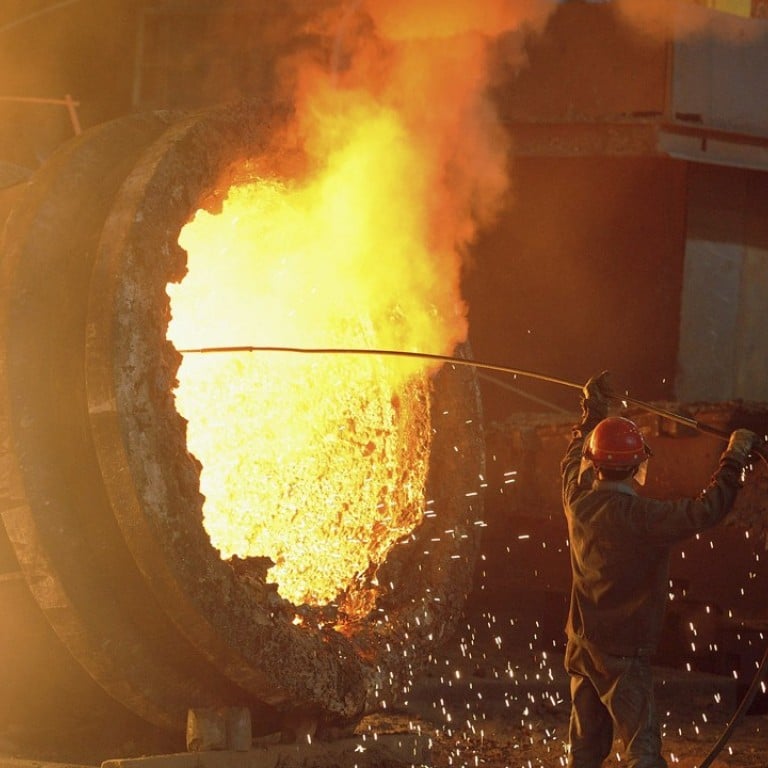Iron Ore Market Volatility: Analysis Of China's Steel Production Curbs

Table of Contents
China's Steel Production Curbs and Their Rationale
China's recent actions to curb steel production stem from a two-pronged approach: addressing environmental concerns and tackling overcapacity within its steel industry. These policies have dramatically reshaped the iron ore market landscape, creating significant iron ore price volatility.
Environmental Concerns
China's stringent environmental regulations are aimed at reducing carbon emissions and improving air quality, particularly in heavily industrialized regions. Steel production is a significant contributor to pollution, releasing substantial amounts of particulate matter and greenhouse gases into the atmosphere.
- Specific Government Policies: The Chinese government has implemented various policies, including stricter emission standards, production quotas, and penalties for non-compliance, targeting steel mills across the country. These measures are part of a broader national strategy to achieve carbon neutrality.
- Pollution Impact of Steel Production: The process of steelmaking generates significant air and water pollution. Particulate matter from blast furnaces contributes to smog, while wastewater from steel mills contaminates water sources. These environmental consequences have spurred the government's decisive actions.
- Affected Regions: Provinces like Hebei, Shandong, and Shanxi, known for their concentrated steel production, have been particularly impacted by the stricter environmental regulations, leading to temporary or permanent shutdowns of some steel mills.
Overcapacity Concerns
China's steel industry has historically suffered from significant overcapacity, leading to depressed global steel prices and unsustainable practices. The government aims to consolidate the industry, improve efficiency, and reduce excess capacity.
- Impact of Excess Steel Production: Overcapacity led to a global glut of steel, depressing prices and making it difficult for steel producers worldwide to operate profitably. This oversupply directly impacted the demand for iron ore, a key ingredient in steelmaking.
- Consolidation Efforts: The Chinese government has encouraged mergers and acquisitions within the steel sector, aiming to create larger, more efficient companies that can better manage resources and reduce overall production.
- Improving Efficiency: Policies focused on technological upgrades and the adoption of more environmentally friendly steelmaking processes are also designed to increase efficiency and reduce waste, thus indirectly impacting iron ore demand.
Impact on Iron Ore Demand and Prices
The reduction in Chinese steel production has directly impacted global iron ore demand and prices, leading to significant iron ore market volatility.
Decreased Iron Ore Demand
As China's steel mills produce less steel, their demand for iron ore, the primary raw material, naturally declines. This decreased demand has reverberated throughout the global iron ore market.
- Decreased Iron Ore Imports: China's iron ore imports have shown a clear downward trend since the implementation of the production curbs, impacting major exporting countries.
- Impact on Spot and Futures Prices: The reduced demand has translated into lower spot and futures prices for iron ore, creating uncertainty for producers and traders.
- Price Volatility: The fluctuating demand has created significant price volatility, with sharp price swings becoming a regular feature of the iron ore market.
Price Volatility and Market Uncertainty
The fluctuating demand for iron ore has created significant price instability, impacting various stakeholders.
- Impact on Iron Ore Producers: Australian and Brazilian iron ore producers, major suppliers to China, have been significantly affected by the price volatility, experiencing reduced revenues and profit margins.
- Risk Management Strategies: Iron ore companies are employing various risk management strategies, such as hedging and diversification, to mitigate the impact of price fluctuations.
- Implications for Investors: The volatility creates both opportunities and risks for investors in the iron ore market, requiring careful analysis and risk assessment.
Global Implications of China's Steel Production Curbs
China's steel production curbs have far-reaching global implications, affecting steel prices, international trade, and geopolitical relations.
Impact on Global Steel Prices
Reduced Chinese steel production has impacted global steel markets, causing ripple effects throughout the industry.
- Impact on Steel-Producing Nations: Steel-producing countries outside China have experienced both opportunities and challenges, with some benefiting from increased export demand while others face increased competition.
- Impact on Steel-Reliant Industries: Industries heavily reliant on steel, such as construction and automotive, have faced supply chain disruptions and cost increases due to fluctuating steel prices.
- Increased Steel Imports: Countries may seek to increase steel imports from alternative sources, potentially reshaping global trade flows.
Geopolitical Implications
China's policy decisions have broader geopolitical implications, impacting international trade and relations.
- Impact on Trade Relationships: The reduced demand for iron ore has strained trade relationships between China and major iron ore exporting nations like Australia and Brazil.
- Potential for Trade Disputes: The policies could lead to trade disputes or retaliatory measures if countries feel their interests are unfairly affected.
- Long-Term Implications for Supply Chains: The changes in the iron ore and steel markets could lead to a reconfiguration of global supply chains in the long term.
Conclusion
China's steel production curbs have undeniably created significant iron ore market volatility. The reduction in demand, coupled with pre-existing market uncertainties, has led to price fluctuations with far-reaching global consequences. Understanding the rationale behind these curbs, their impact on demand and prices, and their wider geopolitical implications is crucial for all stakeholders involved in the iron ore industry. To stay informed on future trends and navigate the inherent volatility of the market, continue to monitor news and analysis concerning Chinese steel production policies and global iron ore market developments. Staying abreast of iron ore market volatility is vital for informed decision-making in this dynamic sector.

Featured Posts
-
 Politiki Otkazalis Ot Vizita V Kiev 9 Maya Makron Starmer Merts I Tusk
May 09, 2025
Politiki Otkazalis Ot Vizita V Kiev 9 Maya Makron Starmer Merts I Tusk
May 09, 2025 -
 High Potential Repeats Why Abc Is Airing Certain Shows In March 2025
May 09, 2025
High Potential Repeats Why Abc Is Airing Certain Shows In March 2025
May 09, 2025 -
 Revealed The Content Of Franco Colapintos Deleted Drive To Survive Message
May 09, 2025
Revealed The Content Of Franco Colapintos Deleted Drive To Survive Message
May 09, 2025 -
 Brekelmans Wil India Aan Zijn Zijde Houden Strategie En Uitdagingen
May 09, 2025
Brekelmans Wil India Aan Zijn Zijde Houden Strategie En Uitdagingen
May 09, 2025 -
 Operation Sindoor Pakistan Stock Market Plunges Kse 100 Halted
May 09, 2025
Operation Sindoor Pakistan Stock Market Plunges Kse 100 Halted
May 09, 2025
